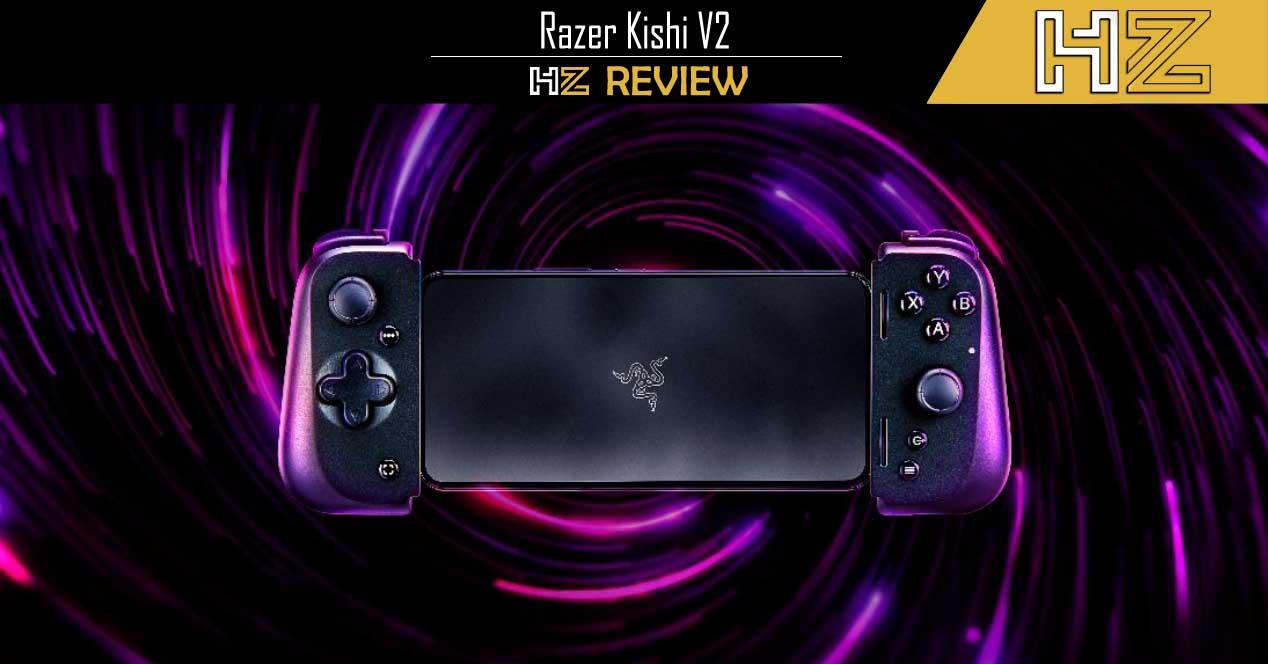So the Kishi V2 does not have a battery and does not connect wirelessly to the mobile device, although it does have a port USB-C to be able to recharge the battery of the mobile via the pass-through.
For the rest, the Kishi V2 provides the usual controls you would expect from a gamepad, in this case asymmetrical with two joysticks, a D-Pad, four main buttons and, in this case, six triggers since it incorporates an additional one. on each side. All the buttons are configurable using the Razer Nexus mobile app, from which we will also find a dedicated interface for games similar to Steam. This command, by the way, is recommended for playing with GeForce now from Nvidia.
Unboxing and external analysis
The Razer Kishi V2 is packaged in a small rectangular hard cardboard box adorned in the brand’s usual colors of black and green. On the front we find an image of the device (of course using a smartphone of the brand as an example) accompanied by its main features, leaving a more detailed description of its advantages for the back. On one of the sides we have even more details.
Inside, the first thing you encounter is the device itself integrated into a black expanded polystyrene protection. We can see that there are also two pieces of plastic, which we will soon explain what they are.
Here you have the accessories that Razer includes with the Kishi V2, and which consist of the usual instruction manual, stickers with the manufacturer’s logo and the two plastic parts that we have seen before, which are nothing more than adapters to be able to adjust the size of the control to the different smartphone thicknesses.
This is the Kishi V2, with its Xbox-style asymmetrical joystick layout.
In the lower part of the right side of the controller we have the USB-C connector to be able to charge the mobile while we use it with the controller to play.
In the internal part of the right area we have another USB-C connector, in this case male. This is where we will logically place the mobile charging port and which will serve to use the remote control with.
You can see that in this area there is a grooved plastic piece, and it is precisely this that we can remove to put the extra one (on each side, of course) supplied with the accessories. The additional parts are thinner and will work for thicker mobile devices.


Let’s go to the rear, in plastic but grooved to improve grip (we miss it, in an order of this price and which wants to be in the Premium category, for having found rubber inserts here). The shapes are contoured to also improve grip.
Below we can see the triggers, with the usual two on each side but an additional smaller one that is multifunctional and is designed so that we can configure it to our liking with the app.


The internal bridge is expandable, so we can adapt the control to almost any smartphone size.


After seeing the device, we will test it to see how it works.
Razer Kishi V2 for Android review
To test this Razer controller, we used a fairly large Android terminal (the brand and model don’t matter, but we can tell you that it is 16.41 centimeters high and 8.8 mm thick without a shell). Installation is very simple, just insert one side of the phone into its corresponding slot and then the other, corresponding to the USB-C connector.
Although it is quite a large device, with a 6.7-inch screen, there is still enough room to fit even larger mobile devices.
On the left side of the controller, terminal contact with the controller is almost minimal.
Of course, be careful with certain details like the camera; Some mobiles, as in our case, have a camera that protrudes a little, and this can be a disadvantage and even an obstacle to their installation in the Kishi V2, although it is true that the additional parts that we have seen before us would allow to install it without too much trouble.
As you can see in the following image, on the opposite side, where the USB-C connector is, the mobile is separated by a few millimeters from the rear “wall” of the controller.
With the controller already “installed”, in a process that didn’t really take us more than 20 seconds, we proceed to install the Razer Nexus app to set it up. It must be said that the mobile terminal first detected the remote control without having to touch anything, and in fact we can move comfortably through the menus using the commands of the remote control. When installing Nexus more of the same, it detected the controller the first time and did nothing.
As we mentioned some time ago, this application not only allows us to configure the controller, but also to access a large library of natively compatible games, and we will see them almost as if we were on a platform. form of game such as Steam or Epic Games.
If we go to the settings we are even given the possibility of associating our account to make live broadcasts from the mobile to Facebook or YouTube, and it is that the remote control has a button to start and stop the transmission by pressing just on it.
The software also gives us the possibility to access customer service, leave comments, see the firmware version or frequently asked questions, but what is really interesting is the Reassignment section, where we can configure the behavior of the buttons on the I send.
The truth is that we expected to be allowed to configure each of the buttons, but the reality is that we can only configure the two extra buttons that the controller has in the trigger area. It’s better than nothing, but it still seems insufficient, really.
Now let’s talk about the controller and the impressions it made on us while using it. Let’s start with the sensations of use, of which we will tell you that the controller has been quite comfortable for us to hold, although it is true that being users with large hands we miss the palm area a little more contoured to further improve subjection. We also lack rubber inserts to improve grip, as we discussed earlier.
Overall, the controller is quite comfortable to use, even after quite a long use. It holds well, the terminal is firmly fixed and does not cause fatigue, so we can say that it has remarkable ergonomics.
As for the sensations of use, it must be said that the two joysticks are very comfortable and also very precise, so we do not miss the fact that Razer does not allow them to be calibrated, as Microsoft does for example in its Elite controllers. The D-Pad works well, neither good nor bad, while the main keyboard is excellent, with a nice click feel and good precision and repeat rate. As for the triggers, the feeling is quite good in the two main ones (R1 and R2, for example), with correct operation as well.
However, the extra buttons have been a bit small and inaccessible for us, really, and we would have preferred that instead of placing them in the trigger area, Razer would have placed them in the bottom area, so that we could press them with the little finger and ring finger in a simple way because these triggers are located exactly where these fingers rest when holding the control with two hands, again as Microsoft does in its Elite controls.
Conclusion and judgment
With the Kishi V2, Razer goes even further to make life easier for gamers who play on their smartphone, by creating an almost universal controller with ergonomics that almost transform the mobile terminal into a portable console. It is of course an essential accessory for those who want to play on mobile but with the convenience of having a console controller, and of course without their own fingers covering the display area of the screen.
Of course, the control has some shortcomings, or rather some aspects that we reasoned could be improved, such as the two additional configurable buttons, which we would have placed as triggers at the bottom in the Xbox Elite style, or rubber inserts instead a simple groove in the plastic to improve the grip of the device, since after all, between the 123 grams of the remote control and the weight of the terminal, the one you hold in your hands will do a lot of weight.
All in all, this is probably one of the best, if not the best controller for mobile devices on the market today, and of course if you’re one of those people who spends many hours playing games with your mobile, it’s is a profitable investment.
For all this, we give the Razer Kishi V2 our gold medal, as well as our recommendation for its excellent performance.























